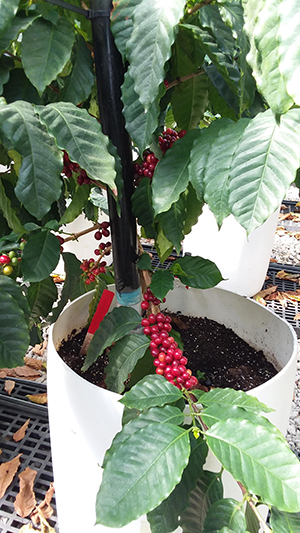
University of Florida/IFAS research hopes to yield a new crop for Florida producers.
Though it is not likely to be ready for farmers for years, coffee is a potential commodity that the state’s growers could utilize one day.
“It’s really outside the box. Often times we’ll start researching a crop, but growers have already started trying to produce it. This one is likely to be farther off into the future because coffee requires those low temperatures for good quality. It’s going to take a bigger lift to identify varietals that would produce good quality in Florida,” said Diane Rowland, chair of the agronomy department and UF/IFAS’ research lead on the project. “It may even become a controlled condition production where maybe we’re in greenhouses or we’re in hoop houses. There’s so many questions on the table. That’s what makes this one particular challenging.”
One pleasant surprise in this project that is still in its infancy is how quickly the plant flowers.
“We brought it into the greenhouse and started to see that it flower, and it produced very, very quickly. That was a surprise. Normally it would take a couple of years in the field for it to become established and to start to produce,” Rowland said. “Almost immediately we saw flowering and some production of berries. That led to the option of exploring, would it be economically feasible under controlled agricultural conditions? That’s one of the questions we’re going to start to explore.”
Unique Plant
Coffee is a unique plant in that it needs temperatures that are low enough but not too low. If it is hit with a frost, it will die. The research team is growing Arabica coffee. It is the most commonly grown variety around the world and the most valuable one on the market.
UF/IFAS is also utilizing artificial intelligence (AI) in its research. Researchers are using minirhizotrons, or clear plastic tubes with tiny cameras inside. These devices are placed underground to record images of the plants’ roots.
“The roots are essential for water and nutrient uptake. The more we understand about where the roots are in the soil, that helps us determine part of the health of the plant itself. The way this camera is set up, we can go back and look at the same place on the roots over time. Normally you would have to dig up, collect soil cores or whatever, to get the roots out,” Rowland said. “This is non-destructive, so we can go back to the same root and see if it’s still alive.”
Another Potential Crop?
One of the main reasons for pursuing a research project like this is it could provide Florida producers another tool in the cropping toolbox. With a climate conducive to various crops, growers like to have options to choose from when deciding what to plant every year.
“I think it’s part of the benefit and part of the detriment of living in Florida. We’ve got these great growing conditions which makes a lot of crops possible. But we also have a lot of issues we have to deal with, from invasive species to diseases to insects. We’ve got climate change. We’ve got changing rainfall patterns, storms, all of those things,” Rowland said. “It makes it important for us to have a diversified agricultural system, too. It’s more sustainable, certainly more economically sustainable for a producer. I think our goal in IFAS is to make sure we provide as many as those opportunities that we can.”









